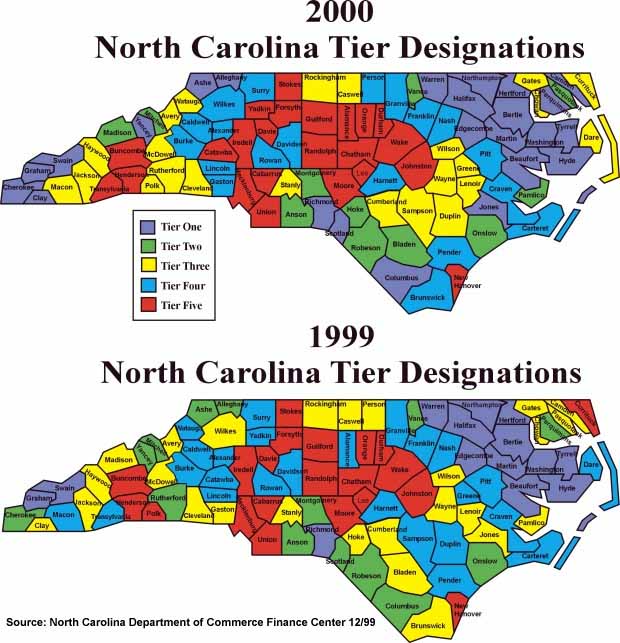State Government
New
Yardsticks
The state redefines "economic distress"
to help counties compete for new industries
By Steve Tuttle 
Question:
If the economy was so good in North Carolina in
1999 then why has the number of counties
considered by the state to be severely
economically distressed nearly doubled?
Answer: Legislative politics surrounding the
state's premier economic development incentives
law, the Bill Lee Act.
The four-year-old law offers the most generous
state tax credits and other incentives to new and
expanding businesses in the poorest counties and
makes the least help available in the richest
ones. A new job created in a poor county earns a
business a $12,500 tax credit, for example; it's
worth just $500 in a well-to-do county. Other
state tax credits and incentives are similarly
scaled.
Each January the law requires the Commerce
Department to reassess economic conditions in all
100 counties and to assign each to one of five
tiers, with Tier 1 counties judged the most
economically distressed and Tier 5 counties the
least distressed.
Thirteen counties fell into the Tier 1
classification in 1999 (Bertie, Edgecombe,
Graham, Halifax, Hertford, Hyde, Martin,
Northampton, Richmond, Swain, Tyrell, Warren and
Washington) but the number jumped to 24 when
Commerce announced its rankings for 2000. New to
Tier 1 are Alleghany, Ashe, Beaufort, Camden,
Cherokee, Clay, Columbus, Jones, Perquimans,
Scotland and Yancey counties, not so much because
local economic conditions deteriorated last year
but because the General Assembly adopted new
yardsticks aimed at making it seem that way.
In fact, in a round-about way of bringing home
the bacon, three amendments to the Bill Lee Act
enacted last summer pushed 24 counties down in
the ranking system, making them eligible for more
generous business incentives than were available
to them last year:
 Counties with fewer than 10,000 residents and a
poverty rate higher than 16 percent automatically
fall into Tier 1. That change affected Alleghany,
which was in Tier 2, and Camden, Clay and Jones,
which were in Tier 3, a relatively middle-class
status.
Counties with fewer than 10,000 residents and a
poverty rate higher than 16 percent automatically
fall into Tier 1. That change affected Alleghany,
which was in Tier 2, and Camden, Clay and Jones,
which were in Tier 3, a relatively middle-class
status.
 Counties with fewer than 50,000 residents and a
poverty rate above 18 percent automatically drop
one tier. Falling to Tier 1 status as a result of
that change will be Ashe, Beaufort, Cherokee,
Columbus, Perquimans, Scotland and Yancey
counties. Retreating from Tier 3 to Tier 2 are
Bladen, Hoke, Madison, Pamlico and Pasquotank.
Duplin, Greene, Sampson and Watauga counties drop
from Tier 4 to Tier 3.
Counties with fewer than 50,000 residents and a
poverty rate above 18 percent automatically drop
one tier. Falling to Tier 1 status as a result of
that change will be Ashe, Beaufort, Cherokee,
Columbus, Perquimans, Scotland and Yancey
counties. Retreating from Tier 3 to Tier 2 are
Bladen, Hoke, Madison, Pamlico and Pasquotank.
Duplin, Greene, Sampson and Watauga counties drop
from Tier 4 to Tier 3.
 Counties with fewer than 25,000 residents cannot
be rated higher than Tier 3. Previously included
in Tier 5, the state's most affluent counties,
Currituck and Polk counties drop to Tier 3 status
as a result of that change, while Dare and Macon
move down from Tier 4.
Counties with fewer than 25,000 residents cannot
be rated higher than Tier 3. Previously included
in Tier 5, the state's most affluent counties,
Currituck and Polk counties drop to Tier 3 status
as a result of that change, while Dare and Macon
move down from Tier 4.
Being rated no higher than Tier 3 has distinct
advantages. In addition to a Bill Lee Act tax
credit of at least $3,000 for each new job
created and a 7 percent tax credit for
investments above $200,000 in machinery and
equipment, new and expanding businesses in those
counties also can claim financial assistance
through the state's Industrial Development Fund.
That assistance amounts to $5,000 for each new
job created, up to $500,000. The money must be
used to renovate buildings, to purchase
production equipment or to improve infrastructure
at new or old sites.
Despite the new yardsticks that tend to push
counties down in the rankings, nine moved up a
notch. Rutherford climbed from Tier 2 to Tier 3,
a change that won't dramatically impact the level
of economic incentives available there this year.
Brunswick, Gaston, Person and Wilkes moved up
from Tier 3 to Tier 4, meaning new and expanding
businesses there won't be available for
Industrial Development Fund assistance.
Alamance, Catawba, Transylvania and Yadkin
counties moved from Tier 4 to Tier 5 and now will
be considered among the state's most affluent
areas, joining Mecklenburg, Wake, Forsyth and
other urban counties as areas considered in least
need of state assistance. The tax credit for new
jobs in Tier 5 counties is worth $500 and the 7
percent investment tax credit for machinery and
equipment only applies to purchases over $1
million.
|

